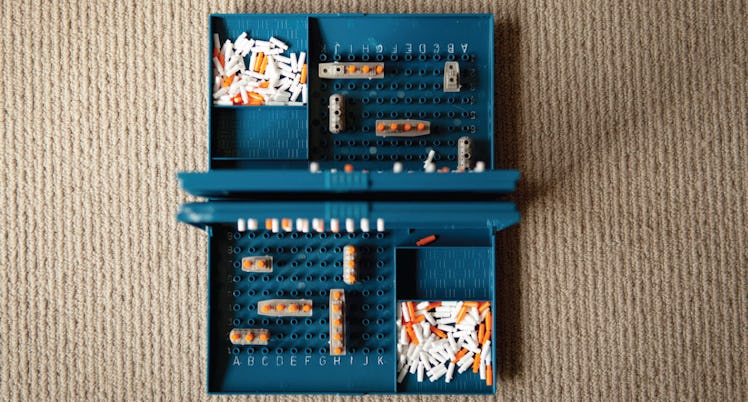How To Beat Your Kid Every Time In Jenga, Battleship, And All The Other Family Game Night Games
Sorry! for the Trouble, but that's Life

For more advice on fun stuff to do with your kids, from ridiculously overqualified experts, check out the rest of our 940 Weekends.
It’s the age-old parenting dilemma: Let your kids win the board game to boost their self-esteem, or send them to bed in tears with the valuable life lesson that the real world isn’t fair and they will never sink your battleship. Sure, psychologists suggest you do both (at least if you’re trying to raise a kid who doesn’t put a hole in his bedroom wall every time he gets beat in Uno), but occasionally you want do the bull dance around the living room.
RELATED: This Simple Storytelling Game Flexes Your Kid’s Creative Muscles
Tom Whipple is a science journalist and author of the book How to Win Games and Beat People: Defeat and Demolish Your Family and Friends! and he has all the best tips and tricks to winning a handful of classic games on family game night. Now it’s up to you to decide whether to completely bankrupt your child in Monopoly, or teach them the wisdom of Mr. Moneybags. It’s a win-win situation — even though they’re going to lose.
Rock, Paper, Scissors: Learn From the Last Round
Only the initial throw-in Rock, Paper, Scissors is pure chance; after that, psychology enters the equation. First thing to keep in mind: Scissors are only played about 30 percent of the time. So if you want to immediately increase your odds throw Paper. From there, you need to factor in irrational human behavior:
- People subconsciously replay a winning weapon. If they beat you with rock, they’re more likely to use the rock again (despite the box office returns for Hercules). Be smart and throw out paper.
- Conversely, if someone loses, Whipple says, they can’t help but shift to the choice that just beat them. If they lost with paper, expect them to throw scissors in the next round. If they really start throwing scissors — timeout.
Jenga: Use Your Arm As A Brace
“There are remarkably few rules in Jenga,” says Whipple: You can’t take a block from the top row, and pieces shouldn’t touch the table, so no flicking. And you can only use one hand. That’s it. Everything else is fair game (or unfair game, as it were). That’s why, regardless of how cheater accusations are thrown around, you can always use these two techniques:
- Place your elbow on the table and brace your forearm against the tower to support it like human scaffolding. Now, with your arm preventing the tower from toppling, pull the pieces toward you.
- When the middle block is gone and the row seems lost, all hope should not be. Simply squeeze the 2 remaining pieces gently together with your thumb and forefinger, moving them from the edges toward the middle. Again, it’s totally legal. When one piece finds the center, pluck the block that’s jutting out.
Operation: It’s All About The Grip
Fake surgery, like any surgery, is all about a steady hand (and all that medical school, hippocratic oath, etc.). Your kid’s got the advantage of youth on this one, Shakes. But Whipple spoke with a real surgeon and gleaned these tips for holding that tiny pair of tweezers: First, grip it with your thumb and ring finger, not your forefinger like a pen (although for extra support, you can use your the other hand). Second, bring your arms close to your body. Wedge your elbows into your sides – that keeps tremors in check. Third, stand up and spread your feet. Now you’re prepared for that 14-hour funny bone removal.
Battleship: Avoid The Sides Of The Board
Don’t worry about the Navy on the other side of the board, “the crucial thing is where you put your ships,” says Whipple. And rule Number One is: don’t even think about the sides or corners. Doing so instantly limits the number of squares your enemy has to guess to locate/destroy your ship. For the same reason, don’t put them next to each other like they’re rafted up on spring break at Lake Havasu.
As for attacking, Whipple says: “Because the smallest ship is only two squares long, you only have to hit every other square when searching.” Maximize each shot and don’t guess adjacent coordinates — you’re wasting valuable sinking time.
Hangman: Guess The Most Frequently Used Letters
Less time has been spent on real Death Row trials than the amount research people have put into winning at Hangman. The key to Hangman is not only to guess the most frequently used letters in the English language, but the most frequently used letters in Hangman. Don’t worry, a computer has figured them out for you: It’s E-S-I-A-R-N. Guess in that order.
Or, if you’re raising one of those kids who dominate the spelling bee, there’s more a complex strategy: Use the length of the word to determine what letter you play first. For example, the most common letter in a 3-letter word is A. If the word has 5 or 6 letters, you should guess S and E, respectively.
Pillow Fighting: Keep One Hand Free, And Hit Hard
Pillow fights are like any other form of combat, which is why Whipple didn’t consult a salesperson at Bed Bath & Beyond, but a retired Special Forces soldier for tactics. Hold the pillow firmly with one hand, keeping the other free to push or pull the target (aka, your kid); point the pillow at the target at all times, so you’re always in proper position to attack; and finally, no dancing around the living room: “Go in fast, hard, and with overwhelming force.”
This article was originally published on